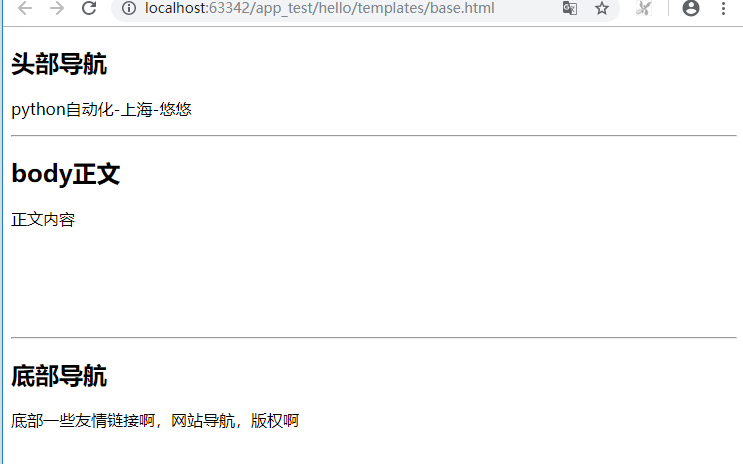前言
当我们打开一个网站的时候,在打开不同的页面时候,会发现每个页面的顶部、底部内容都差不多,这样就可以把这些公共的部分,单独抽出来。
类似于python里面的函数,把公共部分写成函数,然后调用就行了,这样就能实现代码的复用。django里面也有类似的功能,用include可以实现。
公共内容
如下图所示,网站的每个页面都有顶部导航,body正文,底部导航这三块内容

hello/templates/base.html内容
<!DOCTYPE html>
<html lang="en"> <head> <meta charset="UTF-8"> <title>Title</title> </head> <body> <section> <h1>顶部导航</h1> <p>python自动化-上海-悠悠</p> <hr> </section> <section> <h1>body正文</h1> <p>正文内容</p> </section> <section> <br><br><br><br><hr> <h1>底部导航</h1> <p>底部一些友情链接啊,网站导航,版权啊</p> </section> </body> </html>一般头部和底部是不变的,变的只是body里面内容,这样把头部和底部单独抽出来
hello/templates/top.html单独拿出来
<section>
<h1>顶部导航</h1> <p>python自动化-上海-悠悠</p> <hr> </section>hello/templates/end.html单独拿出来
<section>
<br><br><br><br><hr> <h1>底部导航</h1> <p>底部一些友情链接啊,网站导航,版权啊</p> </section>include语法
hello/templates/page1.html
<!DOCTYPE html>
<html lang="en"> <head> <meta charset="UTF-8"> <title>Title</title> </head> <body> {% include 'top.html' %} <section> <h1>body正文</h1> <p>正文内容</p> </section> {% include 'end.html' %} </body> </html>hello/views.py视图函数
from django.shortcuts import render
# Create your views here.
def page1(request): return render(request, 'page1.html')urls.py添加访问路径
from django.conf.urls import url
from django.urls import re_path, path
from hello import views urlpatterns = [ path("page1/", views.page1), ]浏览器访问地址http://127.0.0.1:8000/page1/就能看的效果了
带参数
公共部分top.html和end.html里面也可以传变量,如
<section>
<h1>顶部导航</h1> <p>python自动化-{{name}}</p> <hr> </section>对应视图函数
def page1(request):
context = {"name": "yoyo"} return render(request, 'page1.html', context)前言
当我们打开一个网站的时候,在打开不同的页面时候,会发现每个页面的顶部、底部内容都差不多,这样就可以把这些公共的部分,单独抽出来。
类似于python里面的函数,把公共部分写成函数,然后调用就行了,这样就能实现代码的复用。django里面也有类似的功能,用include可以实现。
公共内容
如下图所示,网站的每个页面都有顶部导航,body正文,底部导航这三块内容

hello/templates/base.html内容
<!DOCTYPE html>
<html lang="en"> <head> <meta charset="UTF-8"> <title>Title</title> </head> <body> <section> <h1>顶部导航</h1> <p>python自动化-上海-悠悠</p> <hr> </section> <section> <h1>body正文</h1> <p>正文内容</p> </section> <section> <br><br><br><br><hr> <h1>底部导航</h1> <p>底部一些友情链接啊,网站导航,版权啊</p> </section> </body> </html>一般头部和底部是不变的,变的只是body里面内容,这样把头部和底部单独抽出来
hello/templates/top.html单独拿出来
<section>
<h1>顶部导航</h1> <p>python自动化-上海-悠悠</p> <hr> </section>hello/templates/end.html单独拿出来
<section>
<br><br><br><br><hr> <h1>底部导航</h1> <p>底部一些友情链接啊,网站导航,版权啊</p> </section>include语法
hello/templates/page1.html
<!DOCTYPE html>
<html lang="en"> <head> <meta charset="UTF-8"> <title>Title</title> </head> <body> {% include 'top.html' %} <section> <h1>body正文</h1> <p>正文内容</p> </section> {% include 'end.html' %} </body> </html>hello/views.py视图函数
from django.shortcuts import render
# Create your views here.
def page1(request): return render(request, 'page1.html')urls.py添加访问路径
from django.conf.urls import url
from django.urls import re_path, path
from hello import views urlpatterns = [ path("page1/", views.page1), ]浏览器访问地址http://127.0.0.1:8000/page1/就能看的效果了
带参数
公共部分top.html和end.html里面也可以传变量,如
<section>
<h1>顶部导航</h1> <p>python自动化-{{name}}</p> <hr> </section>对应视图函数
def page1(request):
context = {"name": "yoyo"} return render(request, 'page1.html', context)